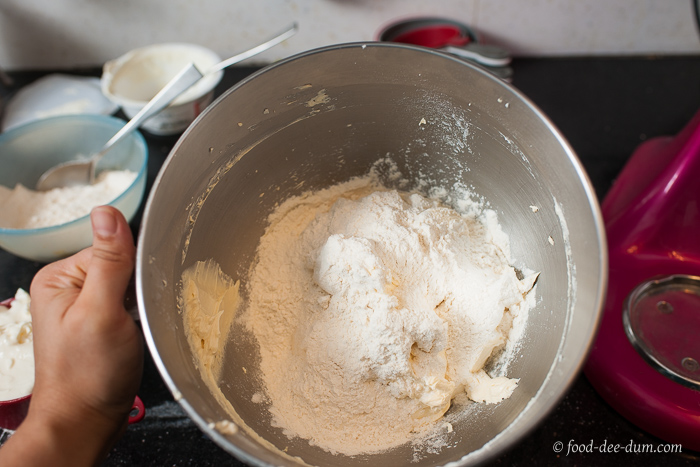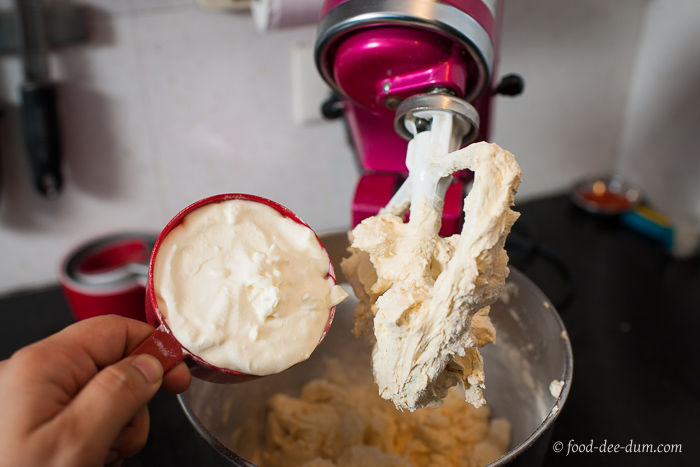Or an Easy “No-Recipe” Cake
The first cake I ever baked was out of a children’s cookbook that was gifted to me for my 9th birthday. It was a simple chocolate cake, a variation of the plain butter cake. But soon after that, my cousin Maneesha taught me the desi version of the classic pound cake. I say desi because, here in India, we don’t measure in pounds!
The best part about the pound cake was that there was no need to remember complicated recipes and quantities. It was straightforward, uncomplicated and almost always had the same result. I clearly remember Maneesha didi’s white enamel mixing bowl and that we used to beat the cake in it by hand. And I mean, literally, by hand. No wooden spoons, no hand beater and definitely no stand mixer. Just our hands. She lived in the house above ours and whenever she felt like baking, didi would give me a holler and up I would scamper. Pull out the weighing scale, the cups, the beloved mixing bowl and an ancient round oven. The result would be a delicious cake and lots of appreciative oohs and aahs from our parents.
Of course, at that point, I had to be supervised around the stove and the oven so didi did all the heavy lifting and just gave me the batter bowl to beat. Over time, she taught me the basics of beating the butter and sugar well, sifting the dry ingredients multiple times to aerate them and mix well, how to grease and flour the cake tin and so on. If it weren’t for her enthusiasm to involve me in her hobby, I don’t know if I would be a passionate baker today. Which is why, every time she visits us from Dallas, I try to fit in a fun baking session with her son. Full circle, maybe?
A classic pound cake is one of the easiest cakes to make and, in my opinion, one of the first that any enthusiastic baker should master. All you need is a pound each of butter, sugar, flour and eggs. And, of course, some baking powder. How didi taught me to make it (since we don’t use pounds and 453 grams is a strange number to work with) was a simple variation. Step 1: decide how large a cake you want – 2, 3, 4, 5 or 6 eggs? Step 2: Weigh them and then use an equal weight of flour, powdered sugar and butter. Plus 1/2 tsp baking powder for each egg. And 1/4 tsp vanilla extract for each egg. And there you have your recipe. No need to remember complicated measurements.
e.g. if 2 eggs weigh approximately 120 grams, then use 120 grams each of flour, sugar & butter. Plus 1 tsp baking powder. And 1/2 tsp vanilla extract. This is usually sufficient for an 8 or 9 inch round/ an 8×8 inch square / 9×5 inch loaf tin. Bake at 160° C for 35-45 mins, or until done.
There are so many advantages to making this cake. One: any enthusiastic baker will always have these ingredients at home. Two: because the ingredients are are weighed, the recipe is usually more reliable. Three: the cake lends itself to many easy flavour variations. Four: it keeps well for quite a few days. Five: It’s versatile – a nice browned crust with a moist, tender crumb makes it the perfect tea-cake. Serve as thick plain slices or slathered with fruit preserves or with whipped cream and fresh fruit. It also makes a wonderful base for other desserts – you can layer slices with fruit and cream, or ganache or a wonderful rich caramel sauce. Need I list more?
This has been my go-to cake for years. But as time went on, I modified it a little. I started using less baking powder and relied more on the creamed butter+sugar for volume and the eggs to get the rise I wanted. It resulted in the cake being a little more moist (more the baking powder, more the cake dries out, in my experience). I also occasionally started adding sour cream to the batter. It makes the crumb even more tender and I’ve always been happy with the result. But you can make the exact same recipe without the sour cream as well. The cake will be very slightly less moist and the crumb, a tad less tender. But it will still work beautifully.
So without further ado, here’s how I make my Classic Sour Cream Pound Cake.
Here’s what I used (for a 10″ bundt pan):
(My original measurements are in grams, but I have tried to approximate for those who may not own a kitchen weighing scale. If you’re one of those, I highly recommend you get one! It’s an amazing addition to a baker’s repertoire and the secret to consistently good cake recipes.)
240 gms Powdered Sugar (~1-1/3 cup)
240 gms Unsalted Butter (~1-1/4 cup)
4 eggs – 240 gms
1 tsp vanilla extract
240 gms All-Purpose Flour (~2 cups)
1 tsp baking powder
1/4 tsp baking soda
1/4 tsp salt
240 gms sour cream (~1 cup)
Here’s how I made it:
Turned on my oven to pre-heat at 160° C and buttered and floured my 10″ bundt cake pan. Because of the crevices in the pan, I like to use a silicon brush to spread softened butter into all the corners and crevices before dusting with flour. You can even use this recipe for 2 loaf pans (9″x5″ each).
Then I placed the dry ingredients – flour, baking powder, baking soda and salt in a bowl and whisked them well to ensure the leavening agents were distributed properly.
Next, I placed the softened butter and powdered sugar in the bowl of my stand mixer and, using the paddle attachment, creamed them together until they were pale, fluffy and seemed double in volume, approximately 4 minutes on high speed.
Once the butter and sugar were well creamed, I added in the eggs one at a time, beating for 1.5-2 minutes between each egg. I also added the vanilla extract along with the first egg.
It’s important to beat well between each egg addition to ensure volume and rise in the cake. Once this was done, I added half the flour mixture and beat on low just until the flour disappeared into the batter, maybe 30 seconds.
Next I added the sour cream and mixed for another 30 seconds, just until incorporated.
Lastly, I removed the bowl from the mixer and added in the rest of the flour mixture, folding it in gently using a spatula.
I spooned the batter into the prepared cake pan and baked it until a skewer inserted in the centre came out clean, about 45 minutes.
I allowed it to cool in the pan for 10 minutes and then upturned it onto a cooling rack. Letting it sit there in the pan for another 5 minutes, I easily lifted the pan off the cake.
That’s it. And we’re done. Once it cooled a little, I dusted the top with powdered sugar. But the shape of this particular bundt has pretty deep crevices so the sugar didn’t show up much. The shape is more suited to a glaze kind of topping!
Simply slice and serve, as is, or with a fruit preserve of your choice. Fresh fruit and whipped cream work wonderfully too. A cup of coffee or tea alongside is just the kind of perfection I live for!
Oh, and also, you can toast it and slather on butter too. This is a brilliant option when it’s a few days old and not as moist as when it starts out! It really is a perfect cake, no?
A few things to keep in mind to make the perfect pound cake, also known as cake basics!
- Room Temperature Ingredients: this is specially important for the butter and eggs. They emulsify better and you can avoid that “curdle” that happens in the batter when you add eggs sometimes. If this does happen though, don’t worry. It usually sorts itself out once you add the dry ingredients.
- Softened Butter: the butter should be soft and not melted or oily. This is important for the butter+sugar to become aerated and develop volume during the creaming stage.
- Add Eggs One At A Time & Beat Well Between Additions: since the recipe cuts down on the baking powder, we need to rely on the eggs as a leavening agent. It helps if they are beaten well, incorporate air and become frothy and voluminous.
Do you have a favourite pound cake recipe? Leave me a comment and tell me about it.
Liked this recipe? Try these other cakes & desserts:
Spiced Pineapple Upside Down Cake, Chocolate Salami, Orange Marmalade Tea Cake, Sooji Halwa Cake, Strawberry Crumble, Baked Caramel Bars with Dark Chocolate Ganache
Same Time, Last Year:
One Year Ago: Sookhi Moong Palak Dal
Two Years Ago: Maharashtrian Shengdana Chutney
Three Years Ago: Sooji Halwa
Four Years Ago: Desi Style Macaroni
Five Years Ago: Stuffed Pizza Samosa
[wpanchor id=”pound”]Classic Sour Cream Pound Cake Recipe
- 240 gms Powdered Sugar (~1-1/3 cup)
- 240 gms Unsalted Butter (~1-1/4 cup)
- 4 eggs (240 gms)
- 1 tsp vanilla extract
- 240 gms All-Purpose Flour (~2 cups)
- 1 tsp baking powder
- ¼ tsp baking soda
- ¼ tsp salt
- 240 gms sour cream (~1 cup)
Equipment Used:- Oven
- 10" Bundt Cake Pan
- Silicon Brush
- Stand Mixer
- Pe-heat oven to 160° C. Using a silicon brush, grease and flour a 10" bundt pan (or two 9"x5" loaf pans) and set aside.
- In a mixing bowl, whisk together the flour, baking powder, baking soda and salt. Set aside.
- In a stand mixer fitted with the paddle attachment, cream the butter and sugar on high speed until light and fluffy, about 4 mins.
- Add 1 egg and the vanilla extract and beat for 2 minutes.
- Add the other eggs, one at a time, beating for at least 1-2 minutes between each addition.
- Gently fold in half the flour mixture, then the sour cream and again the balance flour mixture using a spatula rather than the mixer. Do not over mix.
- Spoon the batter into the prepared cake pan and bake until a skewer inserted in the centre comes out clean, about 45 minutes.
- Allow the cake to cool in the pan for about 10 minutes before inverting the pan onto a cooling rack. Let it rest for 5 minutes and gently lift the pan off the cake.
- Cool completely before dusting with powdered sugar and serve, as is or with fruit preserve or whipped cream and fresh fruit.
- If not consuming the same day, then wrap tightly in clingfilm and refrigerate for upto 5 days.
Please note that this post has affiliate links and if you buy products using these links, it will help support the blog. I will only recommend products that I personally use and/or trust for my family.










